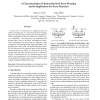Free Online Productivity Tools
i2Speak
i2Symbol
i2OCR
iTex2Img
iWeb2Print
iWeb2Shot
i2Type
iPdf2Split
iPdf2Merge
i2Bopomofo
i2Arabic
i2Style
i2Image
i2PDF
iLatex2Rtf
Sci2ools
DSN
2008
IEEE
2008
IEEE
A characterization of instruction-level error derating and its implications for error detection
In this work, we characterize a significant source of software derating that we call instruction-level derating. Instruction-level derating encompasses the mechanisms by which computation on incorrect values can result in correct computation. We characterize the instruction-level derating that occurs in the SPEC CPU2000 INT benchmarks, classifying it (by source) into six categories: value comparison, sub-word operations, logical operations, overflow/precision, lucky loads, and dynamically-dead values. We also characterize the temporal nature of this derating, demonstrating that the effects of a fault persist in architectural state long after the last time they are referenced. Finally, we demonstrate how this characterization can be used to avoid unnecessary error recoveries (when a fault will be masked by software anyway) in the context of a dual modular redundant (DMR) architecture.
Computer Networks | DSN 2008 | Instruction-level Derating | SPEC CPU2000 INT | Unnecessary Error Recoveries |
| Added | 29 May 2010 |
| Updated | 29 May 2010 |
| Type | Conference |
| Year | 2008 |
| Where | DSN |
| Authors | Jeffrey J. Cook, Craig B. Zilles |
Comments (0)

